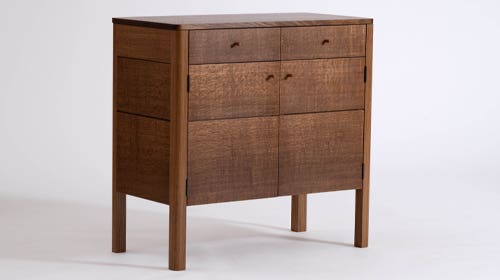Krenov thrived on the road less traveled
Author, lecturer, woodworker and furniture maker founded College of the Redwoods furniture-making program in 1981 {loadposition position10} James Krenov, known worldwide as a woodworker, furniture maker, author and founder of…
Author, lecturer, woodworker and furniture maker founded College of the Redwoods furniture-making program in 1981
{loadposition position10}
James Krenov, known worldwide as a woodworker, furniture maker, author and founder of the furniture-making program at the College of the Redwoods in Fort Bragg, Calif., died Sept. 9 with a piece of wood in his hand at the age of 88. Krenov was an inspiration not only to those who attended his classes, but to thousands of others who discovered and marveled the talents of the furniture maker through his writing and lectures. His first of five books, "A Cabinetmaker's Notebook," (Van Nostrand Reinhold, New York, London, 1976), is considered a classic by the woodworking community.
A summary of the life of James Krenov appears on the College of the Redwoods Fine Furniture Program's Web site and reads as follows:
"James Krenov was born on Oct. 31, 1920 in Wellen, a Chukchee village on the Arctic Circle in Siberia. As his parents sought out a more promising situation, he spent nearly two years with his grandfather in Shanghai.
His mother obtained a position with the Bureau of Indian Affairs as a teacher. Her work took the family to Alaska for two posts, from 1924 to 1928, and from 1930 to 1933.
The family relocated to Seattle where Jim began a career with a nautical bent, working at the Jensen Motor Boat yard where yachts were built and refurbished. He moved on to a ship's chandlery, while spending leisure time sailing small boats around Puget Sound.
As a result of his position at the chandlery and his background, he was sought out as a Russian interpreter for the Lend-Lease program before America's involvement in World War II, and served throughout the duration.
In 1947, Jim moved to Sweden where he worked at a fluorescent fixtures manufacturer. During an excursion to the continent as a "pre-Kerouac hippie" he met his future wife, Britta, who was studying French in Paris. They were married in 1951.
His career as a cabinetmaker began when a display in a fashionable shop in Stockholm captured his interest. Upon inquiry, he found that the graceful, sturdy furniture that appealed to him was made at Carl Malmsten's Werkstada. He was enrolled in the two-year program at the Malmsten school in 1957 after "they let me in just so they could get rid of me."
Upon his graduation, he set up shop in the basement of his home in Broma, Sweden, where his work and his relationship to it gained recognition among peers and acquirers. Early visitors to his shop included Craig McArt and Martin Puryear, who were at the time pursuing academic goals. Commissions during this time included a box to contain a collection of prized ceramics belonging to King Gustav of Sweden.
Jim's abilities as an instructor and speaker began to blossom in the late '60's. He taught at Malmsten's in 1967 and 1968. His international engagements began with an invitation from Craig McArt and Wendell Castle to teach at the Rochester (N.Y.) Institute of Technology. Subsequent teaching engagements included the establishment of the program in Wood Artisanry for the Franklin Institute of Boston University and as a guest professor in Graz, Austria in 1978.
The response of students at RIT led McArt to encourage Jim to try a hand at writing. Publishers of the result, "A Cabinetmaker's Notebook," sent him on a barnstorming author's tour of the U.S. This led, in turn, to an invitation from the University of California at Santa Cruz, to conduct a workshop. Three of the students at that workshop were members of the Mendocino Woodworker's Guild; they enticed Jim to conduct a workshop at the Mendocino High School in 1978. One led to another in 1979, and again in 1980.
In the meantime, Guild members, with support of local board of trustees and instructors, persuaded the College of the Redwoods, a regional community college with a budding branch in Fort Bragg, to establish a cabinetmaking program. The building, in which classes are still held, was finished with the help of the first group of students in the fall of 1981, and was the first building owned by the college in Fort Bragg.
Invitations to speaking engagements continued. He presented two months of workshops as a Fulbright Guest of The New Zealand Crafts Council in 1984. In 1989, the newly established Hida Global Institute in Takayama, Japan, invited him to conduct a series of workshops and lectures. He has also led workshops at Anderson Ranch in 1989 and 1990, and at the Center for Furniture Craftsmanship in Rockport, Maine, in 1995.
Jim's skills were evident long ago; in 1938 he won a bicycle for his entry of a ship's model in a studio promotion of the "Mutiny on the Bounty" starring Charles Laughton.
More recently, he takes pride in being the first non-British recipient of the Annual Award of the Society of Designer-Craftsman's Centennial Medal, bestowed upon him in 1992. The American Craft Council elected him to their College of Fellows in October of 2000, and he was a recipient of the Furniture Society's Award of Distinction, in March, 2001.
His first four books, "A Cabinetmaker's Notebook (1976)," "The Fine Art of Cabinetmaking" (1977), "The Impractical Cabinetmaker" (1979), and "Worker in Wood" (1981), were first published by Van Nostrand Reihold and have since been reprinted by Sterling. A German translation of "The Fine Art of Cabinetmaking," "Die Kunst Des Möbelbaus" was released by Ravensburger in 2000. "With Wakened Hands" was published by Cambium Press in the fall of 2000. A Japanese translation of "A Cabinetmaker's Notebook" was published early in 2009.
Jim retired from teaching at the College of the Redwoods, but continued to build cabinets until his eyes began to betray him. He spent the last two years in his shop making hand planes, and was still eager to share his discoveries in their creation. He could make them by feel as much as by sight.
In early June 2009, it became apparent that he could no longer see well enough to work safely and, on his own terms as ever, he closed his shop. In spite of his discouragement, he was gracious with visiting friends until his last days.
Jim left this world with a small piece of wood in his hand and his family at his side. His ashes will be scattered in the ocean somewhere along his favorite path.
Britta suggests that those wishing to make a contribution in his name do so to the James Krenov Scholarship at the College of the Redwoods."
This article originally appeared in the November 2009 issue.







